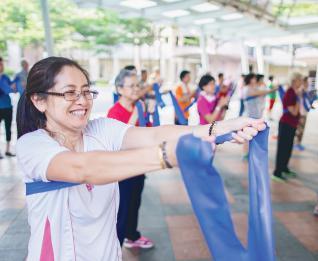
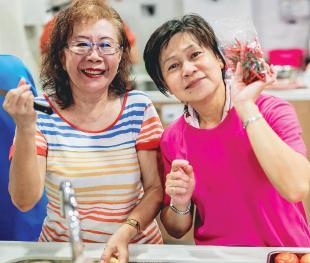
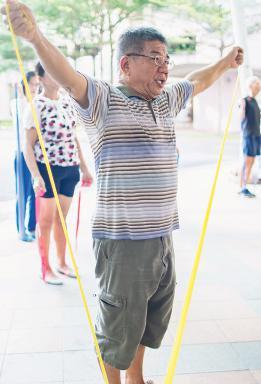
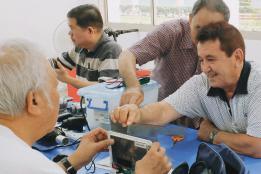




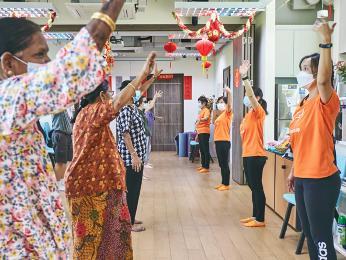




MCI (P) 062/07/2022 ISSUE 2 : APR–JUN 2023 5 THINGS ABOUT GOOD FOOT CARE 28 A HELPLINE TO SUPPORT THE JOURNEY TO RECOVERY 24 DANCING TOWARDS HEALTH & HAPPINESS 18
aha
BY THE COMMUNITY, FOR THE COMMUNITY
10 COVER STORY By the Community, For the Community
Residents of a community are not just consumers of healthcare resources; they can be encouraged to self-manage and support others on health matters
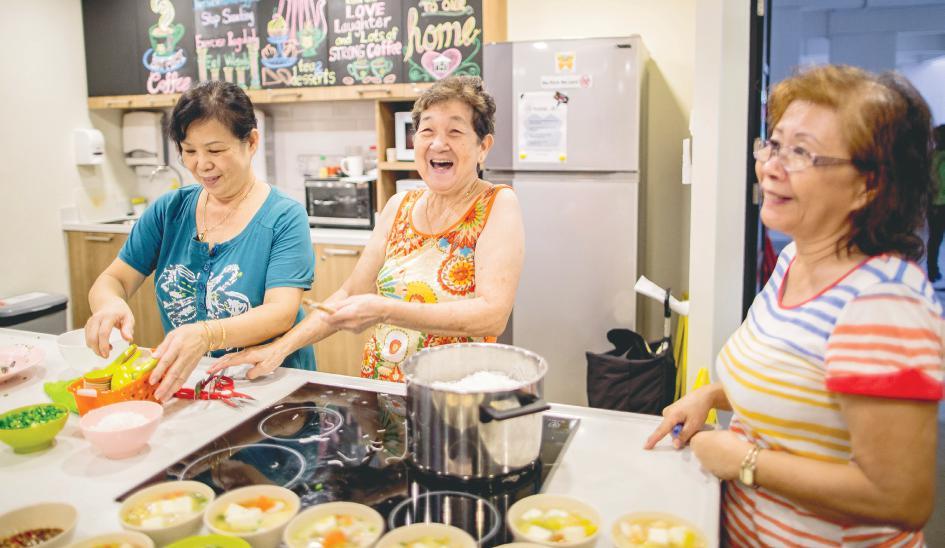
21 LIVE WELL A Passion to Stay Active
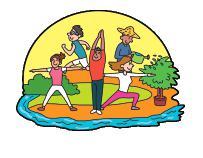
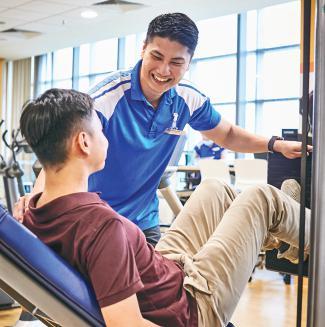
closer to people and empower them
bring
own health, we showcase our approach to participatory care. Moving beyond an institutional restorative perspective, we are tapping into the intrinsic strengths of every person to generate good health in the community. By seeing patients as active producers of health and not just passive recipients of care, we shift the conversation to one that is initiated by people based on what matters to them and what strengths we can uncover in the community.
participate
2 | ontents
WHAT’S UP Community events, outreach efforts, and more 9 YH IN THE NEWS A roundup of Yishun Health appearances in the media
Q&A Health and wellness questions asked and answered!
EVERYDAY HEROES Dancing Towards Health & Happiness Step here to find out more about Dance UP and its volunteers
2 of 3
the follow-up piece of this series on
we
4
16
18
Part
In
how
care
to
in their
WHERE YOU ARE 21
Richmond Ang went from being a HR Executive to a Physiotherapist to pursue his passion
24 SPOTLIGHT
A Helpline to Support the Journey to Recovery
Shining the spotlight on Yishun Health’s Tele-Health & Integrated Network (THINK) Centre
PUBLISHER
Yishun Health is a network of medical institutions and health facilities in the north of Singapore, under the National Healthcare Group. It comprises Admiralty Medical Centre, Khoo Teck Puat Hospital and Yishun Community Hospital. It also includes community extensions such as Wellness Kampung.
EDITORIAL TEAM
Nur Amalina
Hannah Wong
Jack Lau
Sabrina Ng
Sharon Ng
Albert Foo
EDITORIAL COMMITTEE
28
5 THINGS ABOUT…
Good Foot Care
Your feet deserve attention and pampering from you
30 DAILY DOSE
The Spirit of Whole-Person Care
How spirituality can be integrated into person-centred care
32 MAKAN TIME
Vegetable Cream Soup
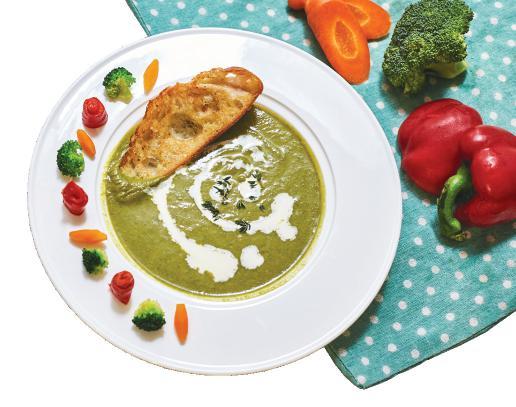
Turn veggie scraps into a warm bowl of comfort!
34 FIT & FAB
Baby, it’s a Good Time to Move!
Exercising before, during and after pregnancy keeps mum and baby in good shape
Scan here to subscribe to aha online for regular updates and stories from Yishun Health!
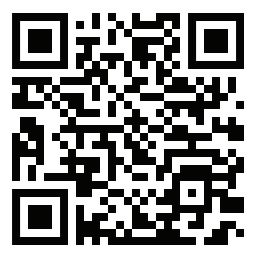
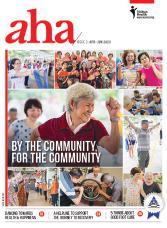
The editorial committee — made up of clinical, nursing, allied health, population health & community transformation, and administrative heads of department — advises aha’s direction.
A/Prof Tan Kok Yang
Bastari Irwan
Caroline Tan
Fatimah Moideen Kutty
Shirley Heng
Teresa Foong
www.ktph.com.sg/ about-us/media/publications aha@ktph.com.sg
PUBLISHING AGENT
THINKFARM PTE LTD
www.thinkfarm.sg
MANAGING DIRECTOR
Christopher Tay
HEAD, EDITORIAL
Chua Kim Beng
CONTRIBUTING EDITOR
Sheralyn Tay
CONTENT CREATOR
Jason Woo
HEAD, CREATIVE Lee Lily
HEAD, CLIENT RELATIONSHIP
Jessie Kek
Why aha?
The name aha holds much significance for us at Yishun Health. In part, it is a nod to our history; it also stands for ‘Advocates for Health in Action’. Through these pages, we hope to empower you to take charge of your own health and discover those ‘aha!’ moments that lead to a healthier, happier you.
CONTRIBUTORS
Justin Loh
Vivienne Looi
aha is the official quarterly publication of Khoo Teck Puat Hospital (Co. Reg. No. 200717564H) and is produced by ThinkFarm Pte Ltd. All rights to this publication are reserved and no part may be reproduced without the expressed written consent of the publishers. While every effort has been made to ensure that the information in this newsletter is accurate and up to date, the editorial team will not be responsible for errors due to information received. Opinions expressed are that of the writers and do not necessarily represent the views and opinions of the publishers. Printed by Mainland Press Pte Ltd. MCI (P) 062/07/2022
| 3
32
We’re LIVE! NGEMR-ready and Prepared for the Future
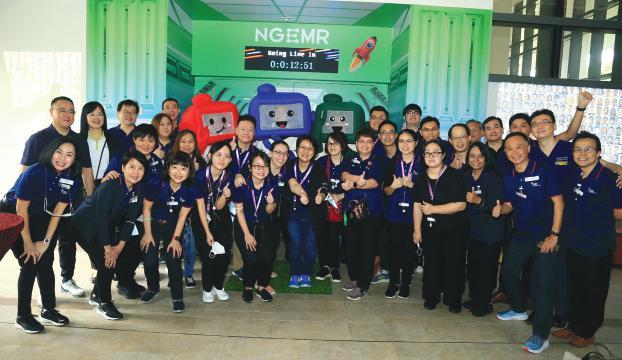
In the early hours of 25 February 2023, Yishun Health marked a milestone in our digitalisation journey when we successfully transitioned to the Next Generation Electronic Medical Record (NGEMR) system. This advanced integrated medical record system, an initiative of the Ministry of Health, harmonises systems and functions across multiple healthcare institutions, enabling patient care details to be captured cohesively and efficiently. This serves
to support the goal of providing seamless care for everyone, wherever they are in the healthcare spectrum. Since 2021, NGEMR has gone ‘live’ progressively across the NHG family.
Yishun Health’s implementation of the new system is the culmination of more than two years of preparation and hard work. As trainers cascaded the training down to all staff, everyone across the organisation worked hard at familiarising themselves with the
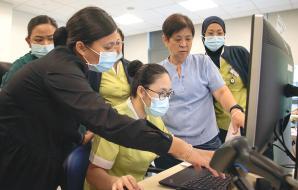

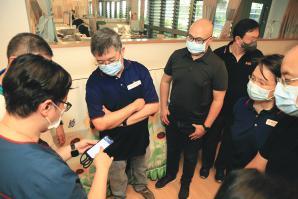
new system and workflows to ensure a smooth transition.
While teething issues for such large-scale implementations are par for the course, Prof Chua Hong Choon, CEO, Yishun Health, shared that the ‘go-live’ went well. “We are appreciative of our staff for their hard work and commitment in getting the hospital ready for the new NGEMR system. This will definitely empower us to deliver better integrated and holistic care for our patients!”
4 | hat’s Up
Partners from other institutions came to celebrate the momentous milestone with us!
CAMIE: Celebrating 10 Years of Restraint-free Dementia Care
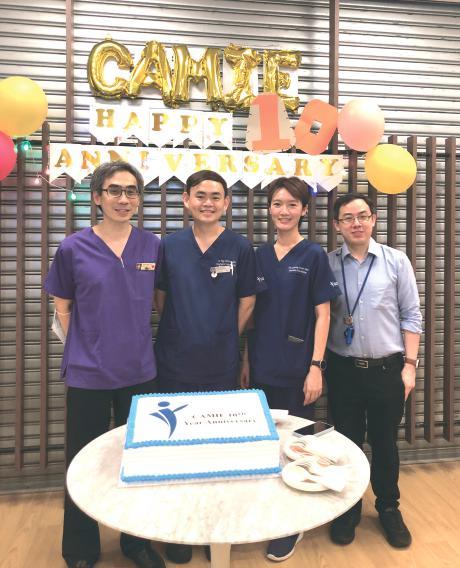
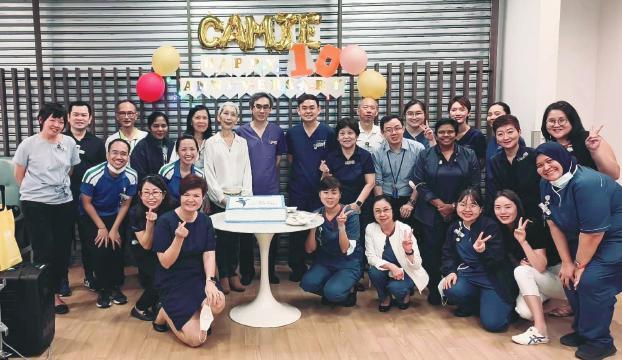
Persons with dementia are highly vulnerable to the unfamiliar and clinical environment of the hospital due to their cognitive, physical and functional deficits. Hospitalisation can stress them out, triggering agitation and aggressive behaviours.
Traditionally, this may involve the use of physical restraints to keep staff and patients safe, as well as to facilitate care. However, KTPH’s CAMIE (Care for the Acute Mentally Infirm Elder) ward has cared for people with dementia restraintfree for a remarkable 10 years, and celebrated this milestone on 22 December 2022.
The CAMIE ward applies a Person-Centred and Age-Friendly Care approach that does away with
restraints. This requires staff to prioritise patients’ needs above routine tasks. The team also honours the dignity, autonomy and choice of every patient, and strives to provide a home-like
environment.
This may mean getting to know them better, encouraging them to bring personal belongings to the hospital, or adapting care to their needs. For instance, a patient with mobility problems and who does not wish to wear diapers is assisted to the
toilet normally, even if this takes more time. By avoiding the ignominy of using diapers against their wishes, the patient’s dignity is upheld, resulting in better cooperation and less chance of agitation or aggression.
The success of CAMIE did not come easily. As the team, led by A/Prof Philip Yap, Senior Consultant, Geriatric Medicine, KTPH, looks back on their journey, they recall the early failures, ongoing challenges, and other emotional and psychological ordeals. It has taken unwavering dedication and teamwork as the team continues to problem-solve, and understand patients and the disease better.
According to Advanced Practice Nurse Jessie Tan, “Caring for dementia patients is complex and requires a high level of patience, passion and purpose. It is incredible to reach the milestone of 10 years of restraint-free care; this could only be possible through teamwork among doctors, nurses, therapists, elder care companions, and volunteers.”
| 5
(L-R) A/Prof Philip Yap, Dr Ng Chong Jin, Dr Cheong Chin Yee and Dr Tay Poh Peng are among the doctors working at CAMIE ward
Staff of CAMIE celebrating the 10-year anniversary of the ward
PowerFacts: A Winning Digital Resource to Empower Caregivers
Since 2010, GeriCare has provided nursing homes with support and supervision as well as specialised geriatric care resources, such as training and tools to raise the level of care. One of these is PowerFacts, a series of educational animated shorts on various end-of-life, palliative and geriatric issues. These include topics such as pain management, stages of grief, and what to expect during the dying process.
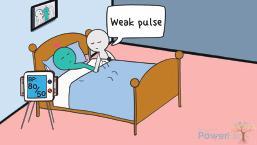

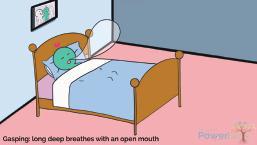

At the 24th Annual Digital Health Awards, a PowerFacts video, Dying Process (What to Expect), was recognised with a Bronze Award under the Digital Health Media/ Publications (Video) category.
The Annual Digital Health Awards, organised by the Health Information Resource Centre in the United States,
honours the best digital health resources developed for consumers and healthcare professionals.
Say Hello to Our New Team Member, TEMI!
Yishun Community Hospital (YCH)’s wards just got a little extra help to serve patients better with the introduction of TEMI, an autonomous robot that can selfnavigate and take on some routine duties. Launched on 28 November 2022, this initiative was co-funded by AIC’s Healthcare Productivity Fund for technology adoption.
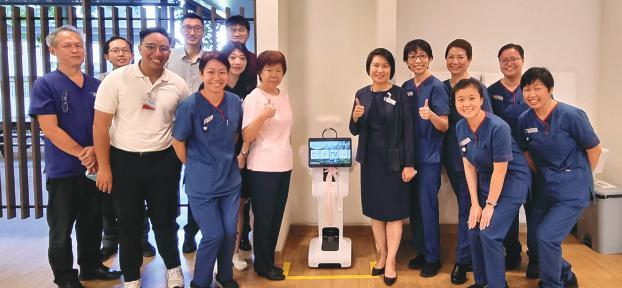
TEMI can move around wards, deliver small items, make announcements, showcase videos, and conduct teleconferences.
Enabled with voice recognition, TEMI is able to ‘listen’ to specific commands, making it easy for nurses to give instructions.
Seven of these robots have been deployed to take on basic ward duties at YCH, freeing nurses to focus on clinical care. Integrated with patient
education videos and translation capabilities, TEMI will also help to improve patient communication, engagement and education.
6 | hat’s Up
Scenes from the video that was recognised at the Annual Digital Health Awards
Setting our Sights on Zero Harm
Health (WSH) Forum for Healthcare held on 9 February.
Apart from receiving an award, Yishun Health also joined 13 other organisations in pledging to Vision Zero, an ongoing safety movement launched in 2015. Vision Zero seeks the commitment of employers, workers, unions and governments to embrace zero harm, a mindset that workplace injury and ill-health are all preventable. To this end, Yishun Health has pledged to:
• Implement a near-miss reporting system
• Encourage staff to speak up for safety
Safety has long been a priority for Yishun Health, not only for patients but our staff as well. In recognition of efforts that have gone
into caring for the well-being of our employees, Yishun Health was among 19 recipients recognised at the 2023 Workplace Safety and
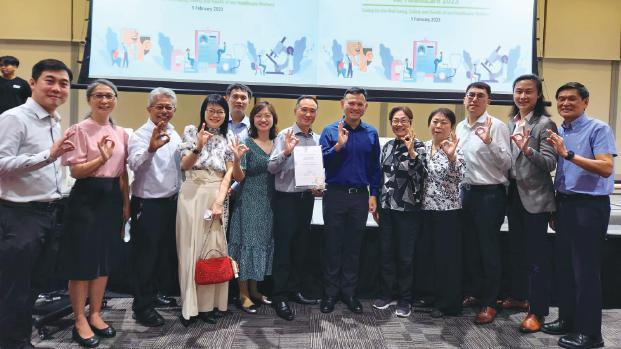
Recognising the Vital Role of Clinical Research Coordinators
Better medicines, treatments and patient outcomes come from the pursuit of rigorous clinical research. Playing an important role to support research investigators and drive the advancement of medicine are Clinical Research Coordinators such as Wan Wen Yi.
A nurse by training, Wen Yi became a Clinical Research Coordinator in 2016, contributing to
a number of significant studies.
One of these was in 2017, when she spearheaded the recruitment for a research study on Familial Hypercholesterolemia. Today, she continues to be a research nurse in this study, which she has helped expand into a multi-centre effort involving several acute hospitals in Singapore. She also works in other related studies to further our
• Engage staff and partners through WSH events
• Encourage partners to pledge to Vision Zero
understanding on the treatment of this condition.
At the 2022 Distinguished Contributor Award for Clinical Research Coordinators ceremony held in January 2023, Wen Yi’s dedication was recognised with a Finalist Award, which honours those who embody the spirit of research and innovation.
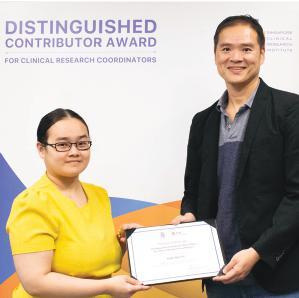
| 7
Attracting the Next Generation of Healthcare Professionals

Yishun Health embarked on a series of engagements with secondary school students in the last quarter of 2022 to promote healthcare as an attractive career.
To this end, we hosted four secondary schools on learning journeys and held various work experience programmes.
Learning Journeys
Students from Victoria School, Kranji Secondary School, Canberra Secondary and Seng Kang Secondary School visited Yishun Health in October and November 2022 for an experiential learning experience with our physiotherapists, nurses, medical social workers, and patient care officers.
Work Experience Programme
Students from CHIJ Secondary School, Zhenghua Secondary School and Woodlands Secondary School took part in a one-week work experience programme at Yishun Health in November 2022.


Hospital Attachment Programme
As part of the St John Ambulance Brigade Hospital Attachment collaboration programme with MOH Holdings (MOHH), Yishun Health provided a training ground for Secondary 3 and 4 St John cadets who held a Basic Home Nursing Course Certificate. During the attachment, they applied their skills and gained insights into real-life patient care scenarios in a hospital setting.
The “Yes I Can!” Healthcare Award
We launched the Yishun Health “Yes I Can!” Healthcare Award for ITE in 2022 for nursing students who have shown great improvement in their results. In this inaugural year, 11 students were recognised. Apart from the awards, an engagement session with award recipients was held via Zoom, hosted by Chief Nurse Ms Shirley Heng.
For more information on scholarships and sponsorships, go to:
KTPH: https://for.sg/joinusktph

YCH: https://for.sg/joinusych
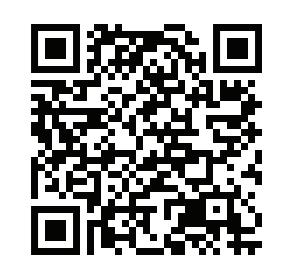
8 | hat’s Up
(Clockwise, from above) Yishun Health organised various work experience programmes, hosted four secondary schools on learning journeys, and held an engagement session with the “Yes I Can!” Healthcare award recipients via Zoom
...on CNA
Started in 2022 by Yishun Health’s Population Health & Community Transformation (PHCT) team, Tune UP is the first community singing for lung health programme in Singapore. It aims to support adults who experience breathlessness in daily life, and who may have conditions such as asthma, chronic obstructive pulmonary disease (COPD), heart failure, or suffer from post-COVID symptoms.
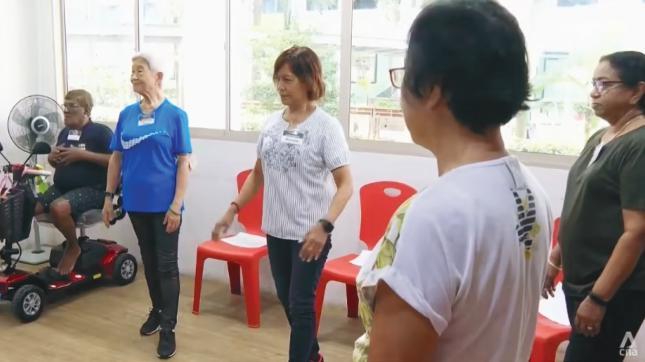
...on KTPH Facebook
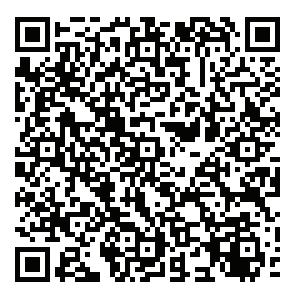
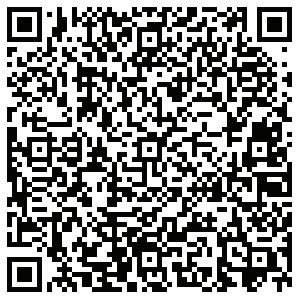
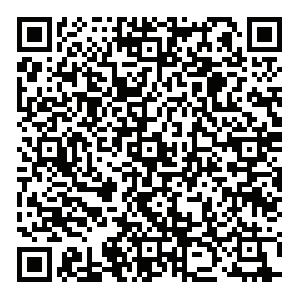
In celebration of Chinese New Year this year, our team of dedicated chefs curated a special menu for patients who were celebrating the festival away from home. Lovingly made with ingredients that symbolise abundance of wealth, happiness, longevity and prosperity, the meal was not only delicious, but also healthy and nutritious. We hope that it brought comfort to patients, and reminded them a little of home.

the
Launched in 2020, KTPH’s Alcohol-Related Frequent Attenders (ARFA) programme aims to motivate patients who misuse alcohol to quit, while encouraging them to reduce their alcohol intake. This article uncovers the hard work and tenacity of KTPH doctors from the Acute & Emergency department, community nurses, and medical social workers to help patients with severe alcohol addiction. Over six months, the team meets patients in their homes or their favourite haunts to bring counselling and basic medical care to them.
Follow us on Facebook & Instagram!
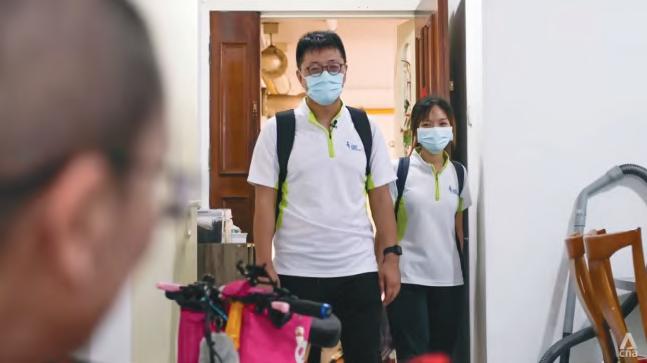
| 9 in the News YH
Photo: Sherlyn Seah/CNA
Scan the QR code to read the CNA news article on how Tune UP has benefited participants.
Photo: Christy Yip/CNA
Scan the QR code to see our chefs in action, as well as
meal prepared.
f @khooteckpuathospital
achieve
personal goals.
Scan the QR code to read the news article on how the ARFA team
helps patients
their
THE COMMUNITY,
FOR THE COMMUNITY
Yishun Health has made a profound shift towards achieving health by activating residents to self-manage and increase their participation in health and care activities where they live.
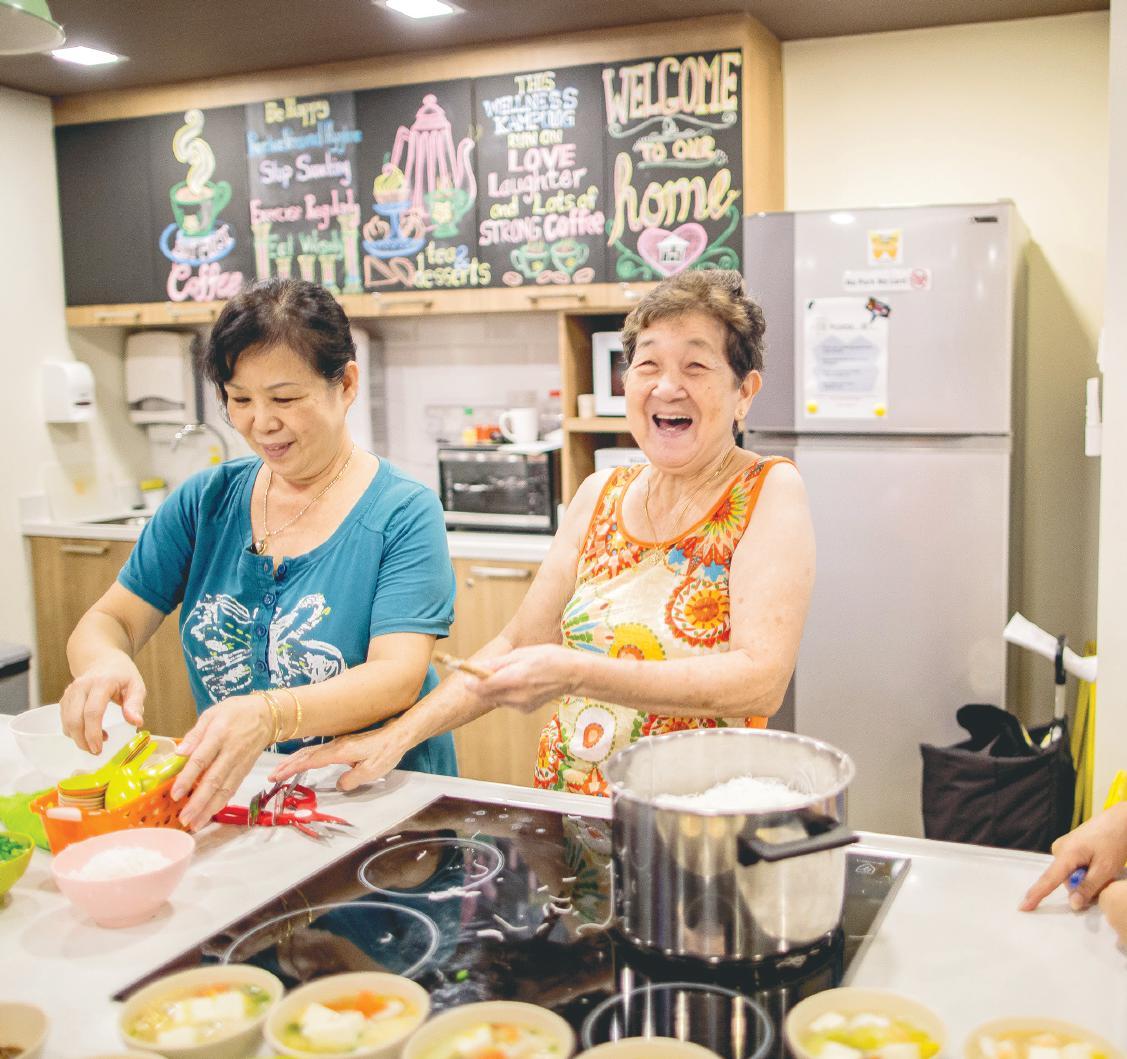
Cover Story BY
Traditionally, we see health through the lens of loss: loss of health resulting in illness, treatment and recovery, and we focus on the causes of disease. This is the pathogenesis (pathos and genesis are Greek for ‘disease’ and ‘creation’ respectively) approach.
But what if we approach health from a different starting point?
Dr Wong Sweet Fun, Deputy Chairman, Medical Board (Community Care & Population Health), and Clinical Director, Population Health & Community Transformation (PHCT), offers an alternative focus on the factors responsible for good health and well-being in a salutogenic (salus is Latin for ‘health’) approach. “Salutogenesis is the search for factors that keep us well,” she explains. “By looking at what keeps people healthy, we fundamentally broaden our perspective from not only providing care to the sick and returning them to health, but also maintaining and promoting health so that people can live well.”
This approach is the crux of Yishun Health’s development of a Participatory Care Ecosystem, where a person is an asset and is seen not only as a consumer of services, but also as a producer and contributor to health and wellness outcomes.


In 2011, soon after Khoo Teck Puat Hospital (KTPH) was set up in Yishun, PHCT initiated conversations with residents living in Yishun, Sembawang and Woodlands, asking them to re-imagine the way health would look in the future. In addition to their aspirations of a good healthcare system, residents shared how they could contribute their personal capability and capacity to selfmanagement and support of others.
“This reframed how we saw our community; not as a potential pool of patients who are passive recipients of care, but as functional people who have the ability to take charge of their own health in proactive, self-directed ways,” Dr Wong recalls. While Yishun Health is able to restore health to patients in the

| 11 WITH YOU WHERE YOU ARE PART 2 OF 3
Residents who live in the same geographical location, e.g. a neighbourhood A collection of residentinitiated, resident-led activities Combined collection of co-produced activities in the community A collection of community-based healthcarefacilitated activities PARTICIPATORY CARE ECOSYSTEM Caring Communities Community Services Ecosystem Communities of Carers Regional Team Connectors Community Nurses Safety Net Services Asset-Based Community Development Local Area Coordination
event of illness or injury, the primary production of health — in large part — lies in the hands of each person through their everyday life decisions.
Yishun Health has built its Participatory Care Ecosystem upon this foundation. Ms Low Beng Hoi, Director of Nursing, PHCT, explains that active participation, whether as an individual or in groups, can drive better health and well-being, “When people participate in each other’s lives instead of being isolated at home, we can stimulate an exchange of health-promoting ideas and self-management practices.” This approach instills a sense of ownership and encourages individual engagement to make healthier life choices.
CREATING PLACES TO COME TOGETHER
Community nodes and spaces are vital infrastructure in Yishun Health’s Participatory Care Ecosystem.
Building on the initial engagement in 2011, Yishun Health ran an
Dr Wong Sweet Fun Deputy Chairman, Medical Board (Community Care & Population Health), and Clinical Director, Population Health & Community Transformation
ethnographic study in 2015 called Project Orange. This study sought to discover the needs and opportunities of the older adults residing in the north by gaining insights into their attitudes and mindsets.
“Many of the individuals who took part in the study were fit and pre-frail individuals who wished to participate, feel valued, and be supported in their later years. However, socio-demographic changes led many of these older adults to feel that their opportunities to be seen, heard and connected were progressively diminishing,” Dr Wong shares.

The study enabled Yishun Health to sharpen its focus and develop more efficient engagement strategies, leading to the co-creation of 21 community nodes over the last 10 years in collaboration with community partners and residents. These include three Wellness Kampung and 15 Community Health Posts in Yishun and Sembawang.
The decentralised nature of these nodes is important. “Community activities should not be run from a giant headquarters,” Evon Chua, Assistant Director, PHCT, points out. “Rather, they should be at the neighbourhood level and created by residents for residents because they are directly attuned to local sentiments and needs.” A variety of activities, based on their collective interests and talents, are co-created by residents for participation at these nodes.
A REPRODUCIBLE CYCLE OF RESIDENT ENGAGEMENT
“These settings provide multiple low-barrier opportunities where
Cover Story 12 |
“This reframed how we saw our community; not as a potential pool of patients who are passive recipients of care, but as functional people who have the ability to take charge of their own health in proactive, selfdirected ways.”
Residents participating in a group exercise at the Wellness Kampung
DECENTRALISE
Develop and maintain a community-based ecosystem of community nodes, where residents can bump into each other, hang out, interact, and create connections
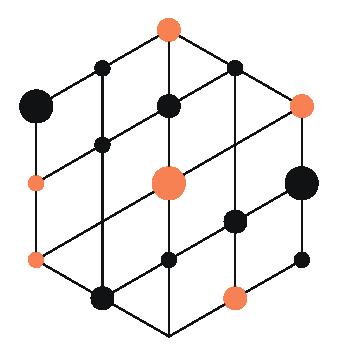
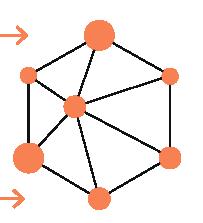
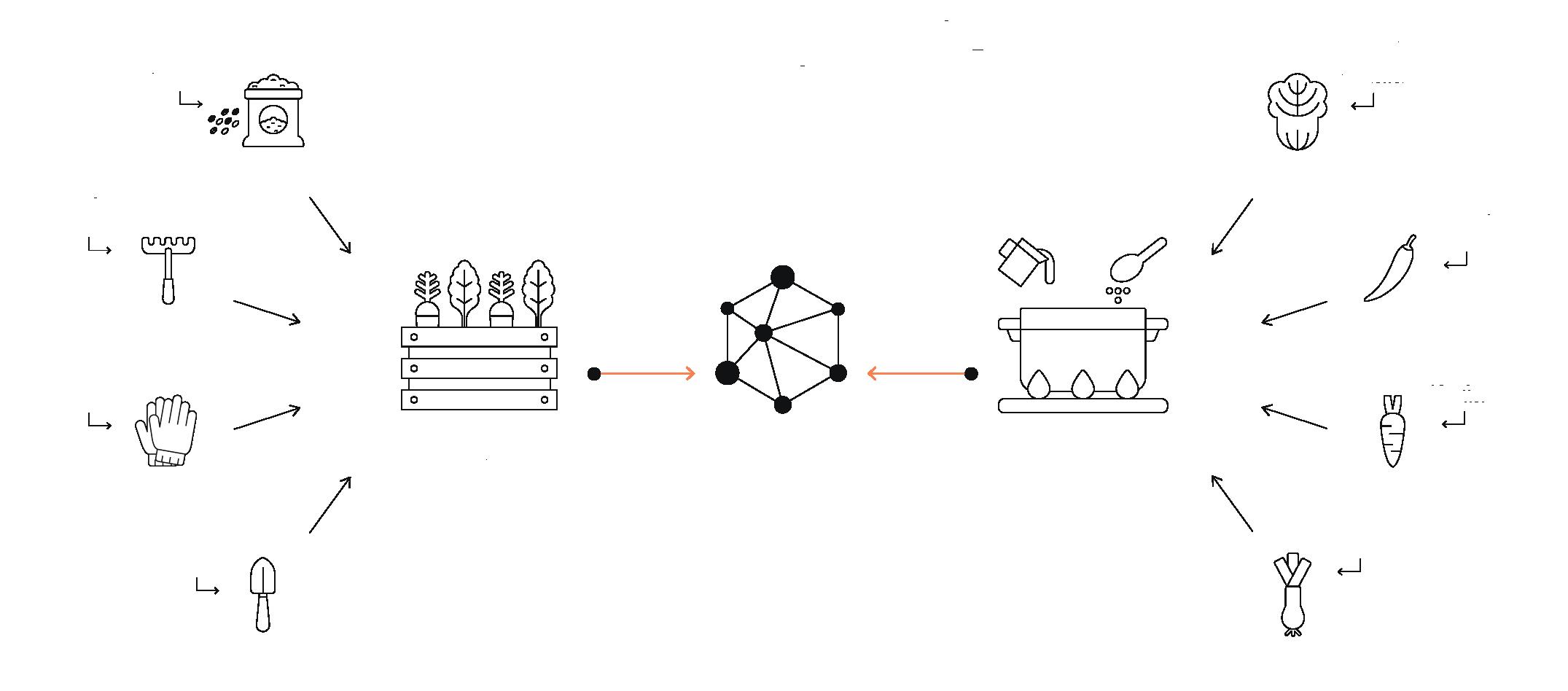
DEMOCRATISE
Encourage a variety of resident-initiated and resident-led activities that revolve around their interests and needs

DISINTERMEDIATE
As residents mix in multiple combinations to build strong social capital and new networks, they take on more ownership to sustain their communities
DIMINISH
As the community grows in its ability to lead, organise and self-care, Yishun Health’s role as activators, facilitators and connectors diminishes
Mr Lim community gardener
Ms Chan teacher
ASSET-BASED COMMUNITY DEVELOPMENT (ABCD)
Everyone Brings Something Contribution Reinforces Agency
Community Garden Community Kitchen Resident-initiated, resident-led activities
Mr Lim community gardener
Ah Ma
Mr Lim’s mother
Ah Seng
Mr Lim’s grandson
LOCAL AREA COORDINATION (LAC)
Conversations & Introductions
Strengths-based, Relationship-based
Sharon volunteer
What matters to you?
This is John. He will go with you to the kopi session. What does a good day look like to you?
Regional Team Connectors Community Nurses

From professional support
residents can participate and produce activities that contribute to their health, maintain their well-being, and care for their community,” says Evon. “They create a virtuous cycle, where success reinforces future activation, production and participation.”
This, in turn, enables Yishun Health to take a step back and play a smaller role in these settings. “After we help our ‘patients’ return to being ‘residents,’ they can take the lead; this allows us to intervene less, put more autonomy in their hands, and diminish our roles, only stepping in when needed.”
Over time, a repeatable cycle of resident engagement at these community nodes evolves, represented by the 4Ds: decentralise, democratise, disintermediate and diminish.
LETTING PEOPLE TAKE THE LEAD
Community-based healthcare-facilitated activities
Combined collection of all activities in the community
To participatory care ecosystem
Two community approaches underpin the Yishun Health Participatory Care Ecosystem: Asset-Based Community Development (ABCD) and Local Area Coordination (LAC).
In ABCD, individuals, groups, stories, connections and exchanges,
local amenities, and local institutions are counted as assets. “We believe that every person, whether healthy or living with long-term conditions and/or frailty, has capabilities and can bring their strengths to the table,” affirms Bastari Irwan, Director, PHCT. Every individual contribution, however small, is important as they reinforce a sense of personal agency. These regular contributions by many people sustain community building in the long-term. Such interactions among people result in a network of trust-based relationships and social capital with valuable exchanges.
| 13
PART 2 OF 3
WITH YOU WHERE YOU ARE
Brian Ah Seng’s friend
Uncle Chan vegetable seller
“This maintains and drives improvements in health and security, influences local economies and food production, and cares for the vulnerable such as children and the frail,” says Elaine Toh, Executive Director, Regional Health Office, Yishun Health.
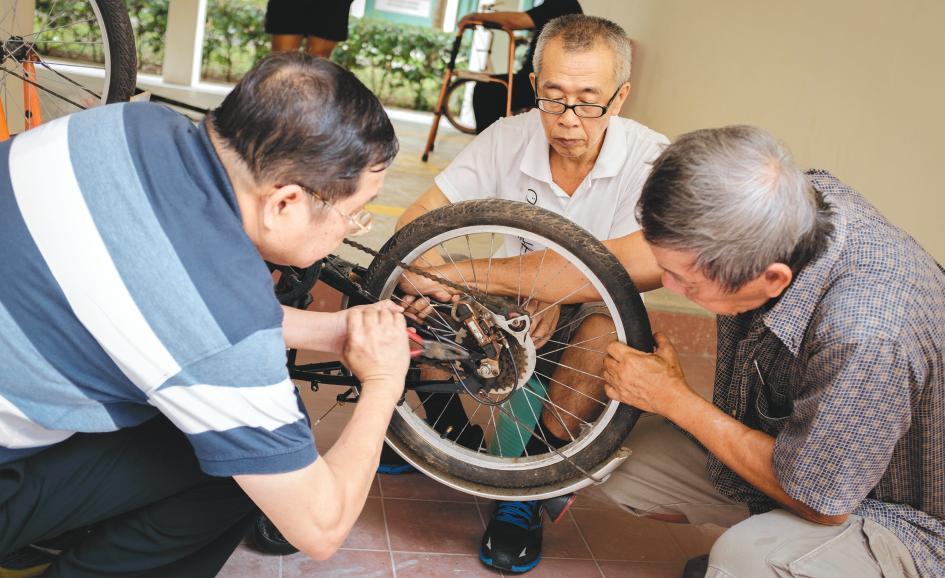
LAC complements ABCD by matching and introducing residents who need help to their local resources. The inclusive supportive community walks alongside them. Bastari says, “Instead of doing things for or to people, we partner with them in a more equal and reciprocal relationship to achieve their personal visions of a good life.” By moving away from overly wrapping services around their needs, the LAC approach lets people decide how they want to balance their capabilities and limitations on their own terms.
Integrating the two approaches, Yishun Health embeds Regional Teams in six geographical zones in Yishun and Sembawang. Each team’s connectors and community nurses — supported by allied health professionals, when needed — build rapport with residents and uncover their capabilities, gifts, community networks, and practical resources that they already have.
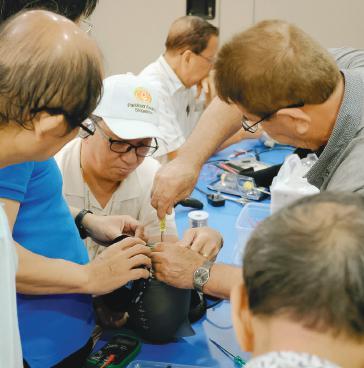
Cover Story 14 |
“When we work in partnership alongside residents in the community, we see that they have the capability to find resources and solutions to support themselves and one another.”
(Above and below) Launched by Wellness Kampung, Repair Kaki brings together local residents with interests and skills in mechanical and electrical repairs to fix appliances brought in by residents
Prof Chua Hong Choon CEO, Yishun Health
The regional teams add value by prioritising an individual’s selfmanaging capabilities and family or peer support before offering health and care services. This builds interdependence and resilience in the community ecosystem. “Yishun Health shifts our contribution from reactive crisis management to responsive capacity building,” adds Dr Wong.
Most significantly, the teams take a de-medicalised approach. Rather than dispensing top-down standard health advice, regional teams practise Personalised Care and Support Planning (PCSP) conversations with each person. These conversations allow residents the space to articulate what matters to them — the priorities that add meaning to their lives. This personcentric approach is more effective in nudging people to take ownership of their goals and then find ways to achieve them.
In this way, people retain their sense of agency with a confidence that allows them to progress from relying on professional support to making active choices for their health, and take the initiative to participate or even contribute to their community. Says Evon, “Our regional teams are still there playing a background role, influencing health practices stealthily, identifying community talent and assets, and encouraging the exchange of good practices.”
“When we work in partnership alongside residents in the community, we see that they have the capability to find resources and solutions to support themselves and one another. The collective result is a healthy, happy, active and caring community, that is sustained by the community itself,” affirms Prof Chua Hong Choon, CEO, Yishun Health.
COMMUNITY-LED HEALTH INITIATIVES
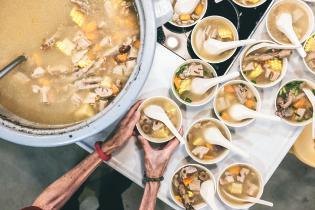

SHARE A POT
Share a Pot was designed to address frailty in the community by dovetailing the principles of good nutrition and exercise, leveraging the benefits of personal contribution and social engagement. Seniors come on their own accord to each session to participate in exercise and enjoy a nourishing meal of bone- and muscle-strengthening soup while forming social bonds and lifting each other up.
DANCE UP
Co-developed with professional artistes and a physiotherapist, Dance UP is a community-led dance programme aimed at supporting residents at risk of falls to build balance, posture, mobility and confidence. Residents gather weekly for sessions that are choreographed by professional dancers but led by residents themselves (turn to page 18 to find out more).
MEMBAWANG KAKYS
This resident group started as an informal gathering in 2018 of five close-knit families living in Blocks 510A and 510B in Yishun Street 51. During the pandemic, the Membawang Kakys rallied to provide support for their old and frail neighbours. They prepared and distributed food and care packs, helped with grocery runs, and checked in on them regularly. Today, they continue to be active in the neighbourhood, and membership has grown to more than 20 people.
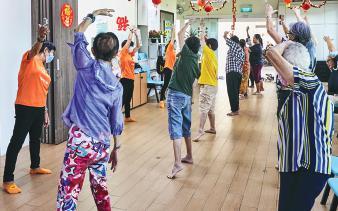
STROKE SURVIVOR SUPPORT GROUP (SSSG)
SSSG provides a support platform for stroke survivors to share information and mutual life experiences. The group provides coaching to increase confidence and self-management among stroke survivors. Importantly, it has peer-to-peer emotional support, which promotes empowerment and helps stroke survivors develop compassion and acceptance of self and others. They go beyond themselves to help others, forging friendships and supporting better quality of life.
| 15 WITH YOU WHERE YOU ARE PART 2 OF 3
Ramadan Fasting Healthy
Yishun Health experts answer your frequently asked questions about health, well-being and medical conditions. In this issue, we answer questions about how our Muslim community can achieve a safe and healthier fasting month.
Some of my family members have health conditions but wish to fast during Ramadan. How can they manage this and what should they discuss with their doctor to ensure their safety?
Depending on the type of medical conditions they have and how stable these conditions are, it may be possible for your loved ones to fast during Ramadan. However, it is essential that they first talk with their doctor or care team so that medications — especially those affected by food intake — can be adjusted safely. Do not change medication dosages without seeking the help of healthcare professionals as it can lead to potential risks and complications.
Fasting is generally safe for those with uncomplicated and stable cases of high cholesterol or high blood
pressure with the guidance of a care team. However, for those with type 2 diabetes, it may be helpful to discuss and plan for fasting up to two months ahead with their doctor. A puasa sunnah or trial fast is also useful to identify potential issues with blood sugar control. Ask your doctor to refer you to a dietitian to discuss your meal plan if you are not sure how to manage it or if you have had issues managing your blood sugar during fasting in previous years.
Gently remind your family members that, while fasting is a major part of Ramadan, Islam exempts those with illness if it adversely affects their health. Instead, they can honour the holy month in other ways that are meaningful, such as paying fidyah (donations to people in need), offering duas (supplications), reading the Quran, praying, volunteering and performing other noble acts.
16 | & A
In consultation with Seow Vi Vien, Dietitian, Nutrition & Dietetics, KTPH, and Muhammad Jazimin Bin Haron, Senior Physiotherapist, Rehabilitation Services, KTPH
What foods are best to eat for suhoor (pre-dawn meal) and iftar (breaking fast)?
Choose foods that will provide satiety and essential daily nutrients while keeping blood sugar levels stable. For suhoor, opt for high-fibre and protein-rich foods that will keep you going through the day. Some ideal choices include wholegrains such as oats, brown rice, whole wheat bread, as well as eggs, lean meats, fish and soy-based protein.
For iftar, it is traditional to break the fast with dates and water or milk. This can be followed by something soupy to kick-start the digestion. The main meal should be well-balanced, nutritious, and include foods from the four food groups:
• rice and alternatives, preferably wholegrain choices
• meat and alternatives
• vegetables
• fruits
Limit your intake of dates to two medium-sized pieces, and do note that this already fulfils your fruit requirement at iftar. Avoid eating too much deep-fried, salty and sugary foods or snacks, drinks or desserts, as these can increase blood sugar levels, causing you to feel sluggish, fatigued and thirsty — this can be challenging during the fasting period. Be mindful not to overeat as well.
Besides food, it is also important to drink eight glasses of water a day during non-fasting hours to stay hydrated. Discuss with your doctor or dietitian on fluid requirements if you are advised to restrict your fluid intake.
How can I exercise safely while fasting?
If you do not have any complex medical conditions, and have been exercising regularly, it is generally safe to perform light to moderate intensity exercises — such as walking, cycling or even jogging — while you fast. However, you should not start a new exercise routine or take up any intense training while in a fasted state.
If you have been sedentary and physically inactive but wish to take up some physical activity during Ramadan, start slow. Incorporate short periods of physical activity in the day, such as walking, taking the stairs, and keeping up with daily house chores.
Avoid being sedentary by including light stretches in between. For those who are already physically active, modify your exercise regime based on your energy levels. A good duration would be between 20 and 45 minutes per session, depending on the type of exercise. Blood sugar levels tend to drop more when performing aerobic exercises compared to resistance or strength exercises. As such, do incorporate a mix of both types of exercises. If you have complex medical conditions including diabetes, your physical activity goals during Ramadan should be to minimise sedentary behaviours and maintain physical activity levels rather than to improve fitness. There is no best time to exercise while fasting; choose what feels most comfortable for you. Depending on your chosen timing, be mindful about hydrating adequately between iftar and suhoor
WHEN PROS CONS
After suhoor (pre-dawn meal) More energy after a pre-fast meal
Before iftar (breaking fast) Ample opportunity to eat and hydrate after (It is important to time your exercise such that it ends just before you break fast)
Risk of dehydration as there will be no opportunity to drink until iftar
No pre-exercise fuel
Blood sugar levels are usually lower nearing to break fast time
(Avoid exercising for prolonged duration as this may further bring down your blood sugar level)
After iftar (breaking fast) Opportunity to eat and hydrate before and after exercise Impacts sleep
Avoid exercising 1–2 hours before bedtime to wind down for better sleep quality
Avoid caffeine as it can increase the risk of dehydration. Importantly, consult your doctor or physiotherapist before embarking on an exercise programme while fasting if you are unsure of your health status, have never exercised, or have a chronic medical condition.
| 17
Dancing towards health & happiness
Led by volunteers, Dance UP is a community dance and movement programme that incorporates healthy activity with meaningful connection. The weekly sessions keep participants active, alert, in touch with their functional abilities, and engaged with their neighbours.

18 | veryday Heroes
(L–R) Sandy, Aunty Ah Tee, Joyce and Beverly
At 82, Aunty Chew Ah Tee is a picture of vitality. With her bright smile, twinkling eyes, and energetic movements, she stands at the front of the room filled with seniors, confidently moving with grace as one of the volunteer leaders of Dance UP. Alongside her is her co-instructor, Sandy Goh, Manager, TOUCH Active Ageing Centre (Wellington), who moves in time with the music and encourages the class with clear instructions.
As the session goes on, resident volunteers Beverly Ong, 51, and Joyce Lum, 61, weave in and out among the group of about 10 seniors to offer guidance where needed, but largely allow their peers space and independence to move and enjoy themselves.
Sandy, 38, who is also an occupational therapist by training, explains that Dance UP is a weekly community dance programme that incorporates evidence-based exercises that aim to lower the risk of frailty and falls. The movements and choreography — developed by dance professionals — are taught by volunteers who have undergone a training programme. This keeps the activity accessible and attuned to the abilities of the participants, who are all 50 years and older.
Apart from dance, the sessions also include stretching, conditioning and mobility exercises. “The goal
is to improve balance, posture and confidence,” Sandy says. “The exercises also boost the ability to perform activities of daily living, maintain cognition, and improve mood.”
TAKING STEPS TO GIVE BACK
For Beverly and Joyce, taking part as volunteers was an exciting prospect. They learnt about Dance UP during a community art class and felt it was a wonderful idea.
Beverly, who enjoys taking part in community events and keeping active with Zumba, yoga and other classes, felt that Dance UP was a different way to keep active and also learn something new. Joyce, a regular of Yishun Health’s Wellness Kampung, thought it would be meaningful to do more than just participate. Being active in many exercise sessions herself, she sees the value of keeping active for health and well-being, and wanted to
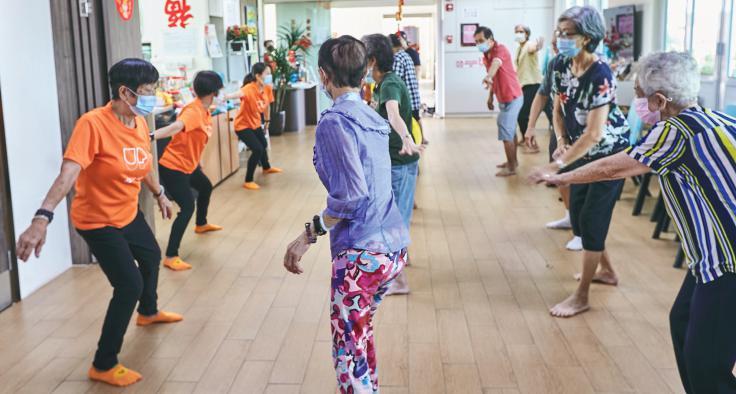
spread that joy. Moreover, they were inspired by Aunty Ah Tee, who was part of the first batch of Dance UP trainees, and is one of the pioneers of the group. “She is such a good example of active ageing!” Joyce said.
Taking on the three-month-long training was no mean feat, as there were many steps and movements to remember, recall Joyce and Beverly. “We had to memorise sequences and proper techniques, so it was a little challenging,” Beverly shares. However, seeing how well the sessions have been received has made the effort worth it. For Joyce, seeing the enthusiasm of residents and their improvement and enjoyment each week is very rewarding.
Not only has attendance been good, but they see participants improve each week as their confidence, strength, endurance and flexibility grow. In fact, during one session, the class was taught how
| 19
(L–R, in orange) Aunty Ah Tee, Joyce and Beverly leading a dance session
“The goal is to improve balance, posture and confidence. The exercises also boost the ability to perform activities of daily living, maintain cognition, and improve mood.”
Sandy Goh Manager, TOUCH Active Ageing Centre (Wellington)
veryday Heroes
to safely move from a chair to the floor and up again. Joyce remembers how one lady was apprehensive, but tried the movement for the first time, encouraged by the support of her peers and the volunteers. “When she managed to get back up from the floor to the chair, she was so surprised that she cried because she said that she had not been able to do this independently for the last 10 years!” So, even though they sometimes feel tired, it is a good kind of tired from moving their bodies and sharing their energy with friends.
Sandy notes that having residents like Aunty Ah Tee, Joyce and Beverly who volunteer to take the lead in Dance UP makes a big difference in the impact of the programme.
“As residents living in Yishun and Sembawang for a long time, they create a sense of community and bonding, bringing people into the Touch Active Ageing Centre not just for Dance UP, but for a host of other programmes and interactions.” This, she adds, helps the centre become a platform for people to create bonds and look out for one another.
“Through Dance UP and all our various activities, we want our
Sandy and Aunty Ah Tee demonstrate stretching movements while Joyce keeps an eye out for participants who may need assistance
residents to make friends with likeminded people, explore new things, and enhance their physical, emotional and social wellness. So even when the centre is closed, the connections we form live on, and they continue to truly care for and support each other.”
COMMUNITY WARMTH & PERSONAL WELLNESS STARTS WITH YOU
Endearingly known as a kai xin guo (‘happy fruit’ or ‘little pistachio’) for her cheerfulness, Aunty Ah Tee, a long-time Sembawang resident, firmly believes that each person must take ownership, be it of their health or their community. An active participant in community events, Residents’ Committee (RC) activities, and
exercise programmes, she attributes her physical and positive mental well-being to leading an active life and building good ties with neighbours in the community.
Aunty Ah Tee shares, “If we want to build a kampung spirit, it must start with ourselves. The same goes for our health — it’s all in our hands!”
Dance UP is a community dance programme that incorporates evidencebased exercises to build balance, posture, mobility and confidence. We are on the look-out for new dance leaders. Call/WhatsApp us at 8044 7591, or email us at danceup@ ktph.com.sg to enquire!
Dance UP is one of the many programmes that PHCT has initiated to support residents in their journey to discover health and well-being. Find out more about Dance UP and other community activities at https:// for.sg/yh-upseries or scan the QR code.
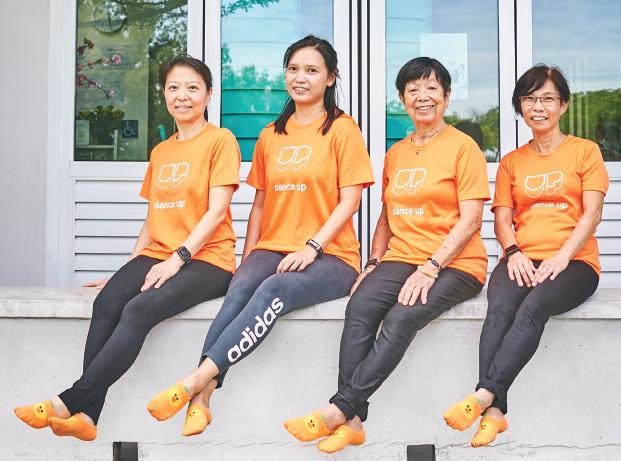
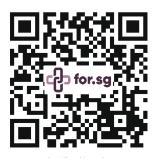

20 |
STAY ACTIVE A PASSION TO
Whether at work or at play, Richmond Ang, has always embraced the active life. Before joining Yishun Health as a Human Resource Management executive in 2017, he was a fitness instructor and wellness coach. It is no wonder that the selfprofessed gym enthusiast spends his free time working out, lifting weights, and going on hikes.
But, more than keeping himself active, Richmond also has a love for encouraging others to do the same. It was what drew him to his work at Yishun Health. Working as part of the organisation’s Human Resource Wellness team, he was involved in planning and implementing various health interventions and

| 21 ive Well
Richmond Ang has always sought life experiences that enabled him to live out his interest in being active. He shares how he went from being a Human Resource Executive to a Physiotherapist — pursuing his passion to keep himself and others moving.
staff engagement activities, such as classes and courses to support psychological wellness, physical wellness, and staff bonding. From inter-department games to cultural celebrations and long service awards, the work was varied and multi-faceted.

REKINDLING A DREAM
It was when he started working on a project to manage metabolic
syndrome that Richmond considered expanding his horizons. “I’ve always had an interest in physiotherapy, but could not do it back then, so I took the closest thing to it — a sports science degree,” he explains.
Being exposed to a more clinical aspect in health interventions, his dormant dream resurfaced. This led him to enrol in the Healthcare Career Conversion Programme (CCP) (previously known as Professional Conversion Programme) to pursue a career switch to become a physiotherapist. Under the Ministry of Health and Workforce Singapore, the Bachelor of Science in the Physiotherapy (Honours) Accelerated Programme offered at the Singapore Institute of Technology (SIT) took two years and eight months.
During this time, Richmond channelled all the discipline and fortitude he had developed working out over the years into the intense study load. “We basically studied non-stop, compressing a four-year course’s load into under three years,” Richmond recalls. “Thankfully, I had the support of my classmates, all of whom were also doing a mid-career switch,
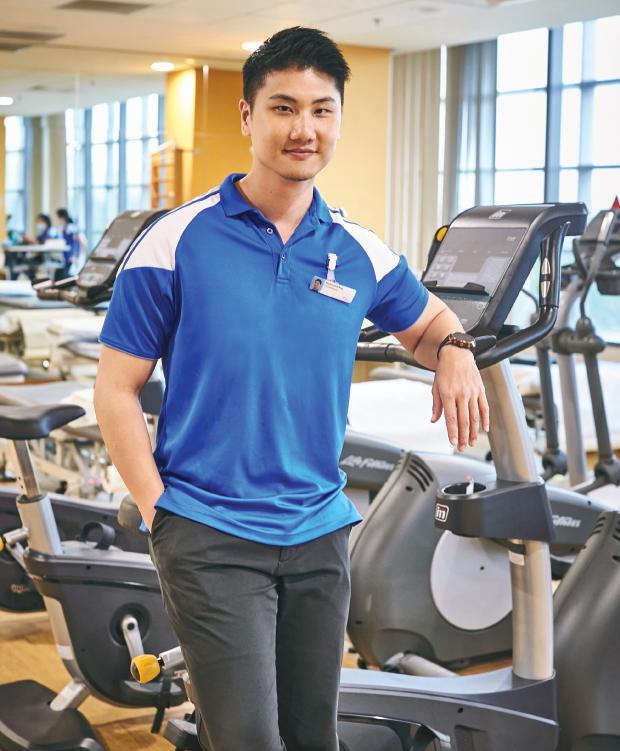
22 |
“We need to always remember that we are not treating conditions; we are treating people.”
ive Well
Richmond Ang Physiotherapist,
Rehabilitation
Services, KTPH
Richmond (top left) was part of Singapore’s first batch of students taking the accelerated physiotherapy programme at SIT
and we cheered each other on.”
Though it was often a struggle, Richmond pushed through, relying on his peers, teachers and skillsets from past work experiences. Most importantly, he was deeply motivated by his dream of helping people live fit, active and quality lives.
MAKING MEANINGFUL PROGRESS
After graduating in 2022, Richmond returned to Yishun Health because he believed in the organisation’s philosophy of care. He is now undergoing supervision as physiotherapist and continues to grow into his new job.

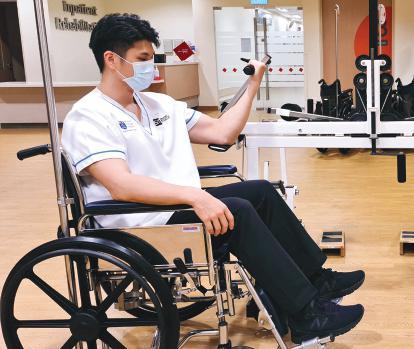
It is a dynamic and varied role, Richmond explains. While people tend to think mainly of physiotherapy within the musculoskeletal field, there are so many more aspects and specialties in the work. “We also work in stroke and post-surgical units, with the older adult population as well as children, and offer a range of techniques to address different needs,” he says.
Amid this diversity are some universal guiding principles, Richmond adds. Most essential of all is person-centric care. “It’s important
to listen to our patients and hear what’s important to them so we can build a therapeutic alliance that helps us to help them achieve their goals,” he shares. “We need to always remember that we are not treating conditions; we are treating people.”
Despite time pressures and patient load, Richmond strives to be present for each patient he sees. He is encouraging of patients whose path to recovery may be more challenging or less direct.
“I remind them that rehabilitation is not a linear progression; there can be setbacks and it’s an undulating process. What counts is that they are making progress overall,” he reflects. He also empowers his patients by teaching them to self-manage so that
they feel more in control of their condition, which helps reduce their anxiety and improve their quality of life.
Richmond uses similar tactics to reframe his own mindset when things get hectic. Sometimes, this means a quick 20-minute cardio session to release stress; at other times, he takes a short mental break to take his mind off work. He also reminds himself of the reasons he switched careers in the first place, and how he is privileged to be in the position of journeying with people on their road to recovery, better function, and better quality of life. “When we’re able to get patients to function better, do what they like, and get back to their lives in the community — that experience is very meaningful!”
Find out how you can make the switch to a healthcare career and join us in Yishun Health! For more information on Career Conversion Programmes, go to https://for.sg/wsgccp or scan the QR code.

| 23
Richmond trying out various equipment during clinical placements
Crossfit is one of Richmond’s hobbies
A HELPLINE TO SUPPORT THE JOURNEY TO RECOVERY
For patients who have been discharged from a hospital stay, the transition home may sometimes be challenging. To support them on their journey to recovery, Yishun Health launched a nurse-led telehealth service, the Telehealth & Integrated Network (THINK) Centre.

24 |
Two days after he returned home from a short stay at KTPH for a bout of asthma, 43-year-old Mr Phillip Tan received a call from a Tele-care Officer. “She asked me how I was doing and made sure I was taking my medication,” he shares. She also checked whether he knew what to do if any new or more serious asthma symptoms came up. This call was reassuring, Phillip says, as it made him feel that someone was looking out for his well-being beyond the medical aspect. It also made him feel confident that, should his condition worsen, help was only a call away.
Calls like this are part of Yishun Health’s efforts to provide support to KTPH patients who are transitioning from hospital to home. The 24/7 urgent-care hotline is run by Telecare Nurses and Tele-care Officers, who provide post-discharge care coordination and case management.
IMPROVING THE ROAD TO RECOVERY
The goal of THINK Centre is twofold. Firstly, says Dr Ang Yan Hoon, Senior Consultant, Geriatric Medicine, KTPH, “It augments our existing hospitalto-home programme, and supports post-discharge patients who have

less complex needs and who do not need home visits. These patients can be supported through telephone calls.”
Secondly, it provides tele-triaging. “It is an avenue for patients to seek clarification on their conditions, so those who face any unexpected changes in health conditions or care needs are able to reach out to THINK Centre staff, who are trained to assess the situation and provide advice and case management, or escalate the issue appropriately and in a timely manner,” explains Dr Tew Chee Wee, Senior Consultant, Geriatric Medicine, KTPH.
| 25
This support for the recovery journey between hospital and home also optimises hospital resources, adds Mah Kwok Kin, Assistant Director, Community Transformation Office, KTPH. “With more seamless and proactive post-discharge telehealth coverage, THINK Centre reduces unnecessary Acute & Emergency Care attendances for nonemergency scenarios, freeing capacity for those who need it more. But it also ensures that patients who develop serious adverse events seek timely and appropriate care, and overall this leads to more appropriate utilisation of healthcare resources at a system level.”
GUIDANCE TO RECOVER BETTER
Wong Sue May, Senior Staff Nurse, is among the eight Tele-care Nurses who are part of the THINK Centre team. Working alongside her are Tele-care Officers, such as Zaiton Binte Janidi, who also play a role in offering advice and assistance to patients. They advise patients on


managing their symptoms and link them to other services, if needed, such as obtaining an earlier medical appointment or referrals to care support teams and community services.
Sue May shares that Tele-care Nurses largely handle patients who require more support. They may have more than one chronic illness, or more complex medical needs and histories. “Cases are assigned to us from across the different wards,” she explains. “We screen each case to understand each person’s issues and needs. For patients with more than one issue to address, we focus on the most critical one first.” She says that, during the calls, she strives to ensure that patients receive the information they need to follow treatment plans and selfcare. “Importantly, we also reinforce the escalation plans so that they’re always prepared,” she adds.
For Zaiton, her role as a Telecare Officer is similar, although she handles a different profile of patients. While she does not have a medical background, she is trained to handle patients with conditions that are less complex. “My patient profile is generally younger — with
potlight 26 |
“She was grateful for the calls and very happy when she found out about Wellness Kampung and other community events — she has since become a regular, and is much happier and healthier.”
WONG SUE MAY SENIOR STAFF NURSE, THINK CENTRE
(L–R) Mah Kwok Kin, Zaiton Binte Janidi and Wong Sue May provide support for post-discharge patients via phone calls
conditions such as gastroenteritis, gastritis, eczema or asthma — who do not require complex medical intervention.” Nevertheless, she similarly helps patients to handle their conditions well at home, such as emphasising care plans, avoidance of triggers, and recommendations to reliable health resources.
In fact, Zaiton often points them to Community Health Posts, the Wellness Kampung, and Senior Activity Centres where they can gain more education and support. “I encourage them to connect with community nurses so they can learn more about managing their chronic illnesses, make healthier lifestyle choices, as well as have a chat regarding Personalised Care and Support Planning,” she says.
CARING BEYOND MEDICAL NEEDS
Beyond taking care of their patients’ immediate medical needs, Sue May and Zaiton find that their role frequently sees them keeping an ear to the ground for other functional and psychosocial issues. Through careful questioning and active listening, they sometimes flag other issues and activate other Yishun Health care teams to step in.
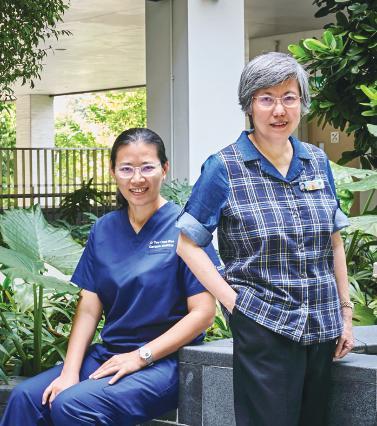
For example, Zaiton found out during a routine call with an elderly gentleman that he was staying at
home a lot more because he was afraid of falling. The 70-plus-year-old had suffered several falls prior to the one that led to this hospitalisation. Learning this, she brought up his case with the team doctor and nurses, and home visits were organised to roll out physiotherapy and community nursing support to reduce his fall risk.
Sue May has also gone the extra mile, coordinating accessibility plans for one wheelchair-bound resident who was stuck at home and unable to go for his dialysis sessions due to lift upgrading works at his block. In another instance, she helped a lady connect with her community network. Not being from Singapore, she had no family or close friends, and would cry over the phone due to loneliness and isolation. “She was grateful for the calls and very happy when she found out about Wellness Kampung and other community events — she has since become a regular, and is much happier and healthier,” Sue May shares.
These stories are a heartwarming boost to the THINK Centre team, who often find it challenging as rapport-building is more difficult over the phone compared to face-toface interactions. “It is encouraging
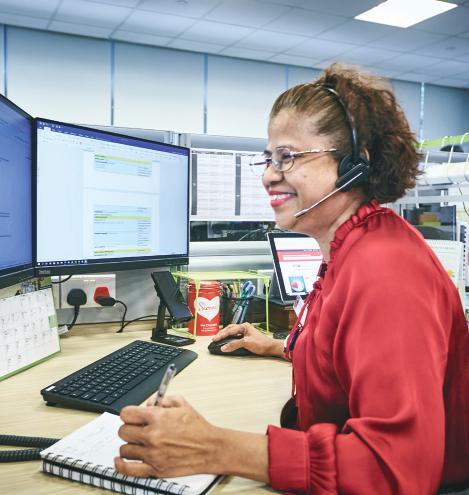
to encounter such patients, and it makes the job fulfilling,” says Zaiton. Knowing that they are also empowering patients in their postdischarge journey by equipping them with the skills, confidence and resources to better manage their health conditions is very rewarding, adds Sue May.
It also helps that this effort plays a crucial role in improving quality and cost efficiency in the healthcare system by integrating, connecting and coordinating care even as the nation pursues the Healthier SG drive. As Kwok Kin points out, “In the long run, THINK Centre serves as a key system transformation bridge towards moving care into the community.”
| 27
“It augments our existing hospitalto-home programme, and supports post-discharge patients who have less complex needs and who do not need home visits.”
DR ANG YAN HOON SENIOR CONSULTANT, GERIATRIC MEDICINE, KTPH
(L-R) Dr Tew Chee Wee and Dr Ang Yan Hoon work closely to lead the THINK Centre team
5Things About...
With every step you take, each of your two feet takes on 1.5 times your body weight; in a lifetime, they would have carried you across the globe four times. For all they do to keep you going, your feet deserve some attention and pampering from you.
GOOD FOOT CARE 1
In consultation with Alexandra Foo, Podiatrist, Podiatry, KTPH
GOOD FIT = GOOD FEET
Foot pain is commonly caused by ill-fitting shoes. While dress shoes and high heels are fashionable, prolonged use may lead to pain, strain and deformity. The ideal shoe should be covered to protect the feet, and have a wide toe box that allows your toes to move freely. It should also fit just right, with a finger’s spacing at the back to prevent blisters and abrasions.
28 | Things About...
2STRAIGHT DOWN THE LINE
To prevent ingrown toenails, always cut nails to the level of your toe flesh as a guide and avoid cutting deep down at the edges. This prevents the corners of the nail from growing into the surrounding skin, thus causing pain.
4WATCH OUT FOR FUNGAL INFECTION
Confined all day in the moist, dark conditions of your shoes, your feet are prime targets for fungal infections, which can look like white wet skin between the toes, dry round patches of skin, peeling and itchy areas, or blisters. To treat such an infection, try applying an anti-fungal powder or cream, but see a doctor if the problem does not resolve within one to two weeks. You can prevent fungal infections by keeping your feet dry and clean.
3MAKE SPACE, TRIM DOWN, OR SEEK HELP
If you do develop an ingrown toenail, try taping the skin around the sides of your toes so that they move away from the nail. This gives the nail more space to grow. You can also use clean nail clippers to trim down the sharp edges and round them out. Do also wash the area daily with an antiseptic solution to prevent infection. However, if your ingrown toenail does not get better in a few days, see a doctor for a referral to a podiatrist.
5SMOOTHING OVER THE ROUGH SPOTS
Everyday exertion and pressure can lead to a build-up of hard skin on the feet and cause sores, blisters and dry, rough patches. Regularly scrub or file your feet in the shower to remove excess skin before it gets too thick. Do not use sharp blades or scissors as this can cause injury and infection.
| 29
THE SPIRIT OF WHOLE-PERSON CARE
Although it may not always be obvious, spirituality is an important aspect of healthcare. As healthcare providers enhance the ways they look after people — not just patients — the spiritual aspect is becoming a major component of whole-of-person care delivery. Here is what spirituality can look like and how it can be integrated in person-centred care.
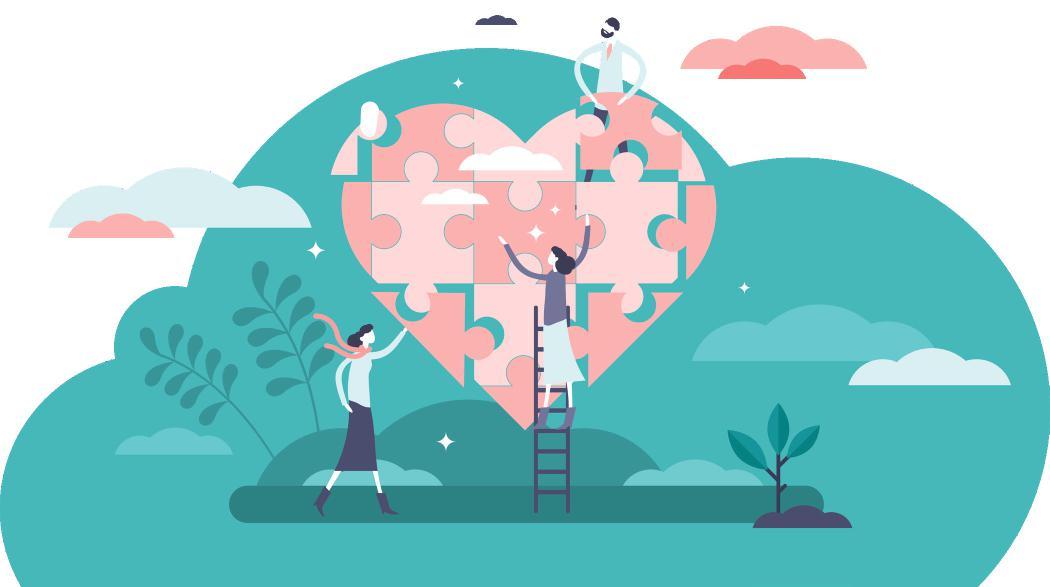
In consultation with Dr Tan Hwee Huan, Senior Consultant, General Medicine, KTPH
Spirituality and religion are interconnected, but are different concepts that help us as individuals shape our beliefs around the meaning of life and our connection with others. Whether one is religious or not, every person
has spiritual needs, because these are inextricably linked to human needs:
• The need to love and be loved
• The need for meaning and purpose
• The need for support and hope
• The need for dignity and respect
30 | aily Dose
In the healthcare setting, seeing to spiritual needs helps in the delivery of whole-person care, where care providers look beyond clinical and physical aspects to address more holistic needs. Studies show that spirituality is linked to physical and mental wellness, and that greater attention to spiritual needs can help patients live longer, cope better with pain, illness and stress, and enjoy a better quality of life.
There are many ways to address spiritual needs. Spirituality is different for everyone; it is deeply personal and individual, and that is what makes it spiritual. In the healthcare arena, this can take form in several ways, such as, but not limited to:

• Creating conducive environments that cater to human needs. This can range from functional design and age- and disability-inclusiveness, to
incorporating nature and other features that promote independence, safety and overall wellness.
• Personalised care and support planning , in which people are the main driver of their own health plans and goals, and where they are engaged and empowered as active and self-directed agents of their health, while being supported by a care team.
• Using tools to help people reflect on and articulate their personal preferences for care, such as Advance Care Planning or similar tools that help someone share their plans for future health and personal care. This usually includes discussing personal beliefs and goals for care.


• Encouraging mindfulness , gratitude journaling, meditation, prayer, breathing exercises or other forms of self-care or activity that aids people to connect with what is personally meaningful and kindles a sense of introspection and peace.
SPIRITUALITY
Not a defined set of beliefs, but a more personal expression of what is meaningful to you on an individual level. It may encompass the pursuit of meaning or purpose, and how you live out those values. It can manifest in a broad number of ways, including beliefs, values, traditions and religious practices.
RELIGION
An organised belief system that is clearly defined, and sets out what you should believe in and why, including a set of practices on how to live out those beliefs. It is usually associated with a specific God(s), and includes ideas of heaven, nirvana or reincarnation.
| 31
VEGETABLE CREAM SOUP
This healthy vegetable soup turns scraps into a warming and satisfying bowl of comfort. Save them in the fridge or freezer to have handy whenever you want to make this flavourful meal.
Recipe provided by Loo Tzy Siong, Chef De Partie, Food Services, in consultation with Nutrition & Dietetics, KTPH
INGREDIENTS
Serves 4
• 50g margarine
• 150g onions, chopped
• 2 cups vegetable trimmings, washed
• 4g lower-sodium salt
• 1 litre water
• 150ml low-fat milk
• 100ml cream
• Cornstarch slurry
NUTRITIONAL INFORMATION (PER SERVING)
Energy
Carbohydrates
Protein Fat
• Saturated
• Polyunsaturated
• Monounsaturated
Cholesterol
Dietary Fibre
Sodium
Potassium
Phosphate
METHOD
1. Add margarine to a pre-heated pot
2. Sauté onion till fragrant and translucent
3. Add vegetable trimmings and sauté
4. Season with half the salt and slowly pour in the water
5. Simmer till the vegetables are tender
6. Remove the vegetables and broth from pot and blend them in batches till smooth
7. Strain the soup and return it to the pot
8. Add the cream and lowfat milk, and thicken with cornstarch slurry
9. Season to taste with the rest of the salt
TIP: Use trimmings from carrots, cauliflower, potato, capsicum, broccoli, mushrooms and more to add flavour and fibre to your soup


189kcal 10g 5g 16g 7g 2g 4g 28mg 4g 391mg 532mg >78mg
32
cut & keep cut & keep
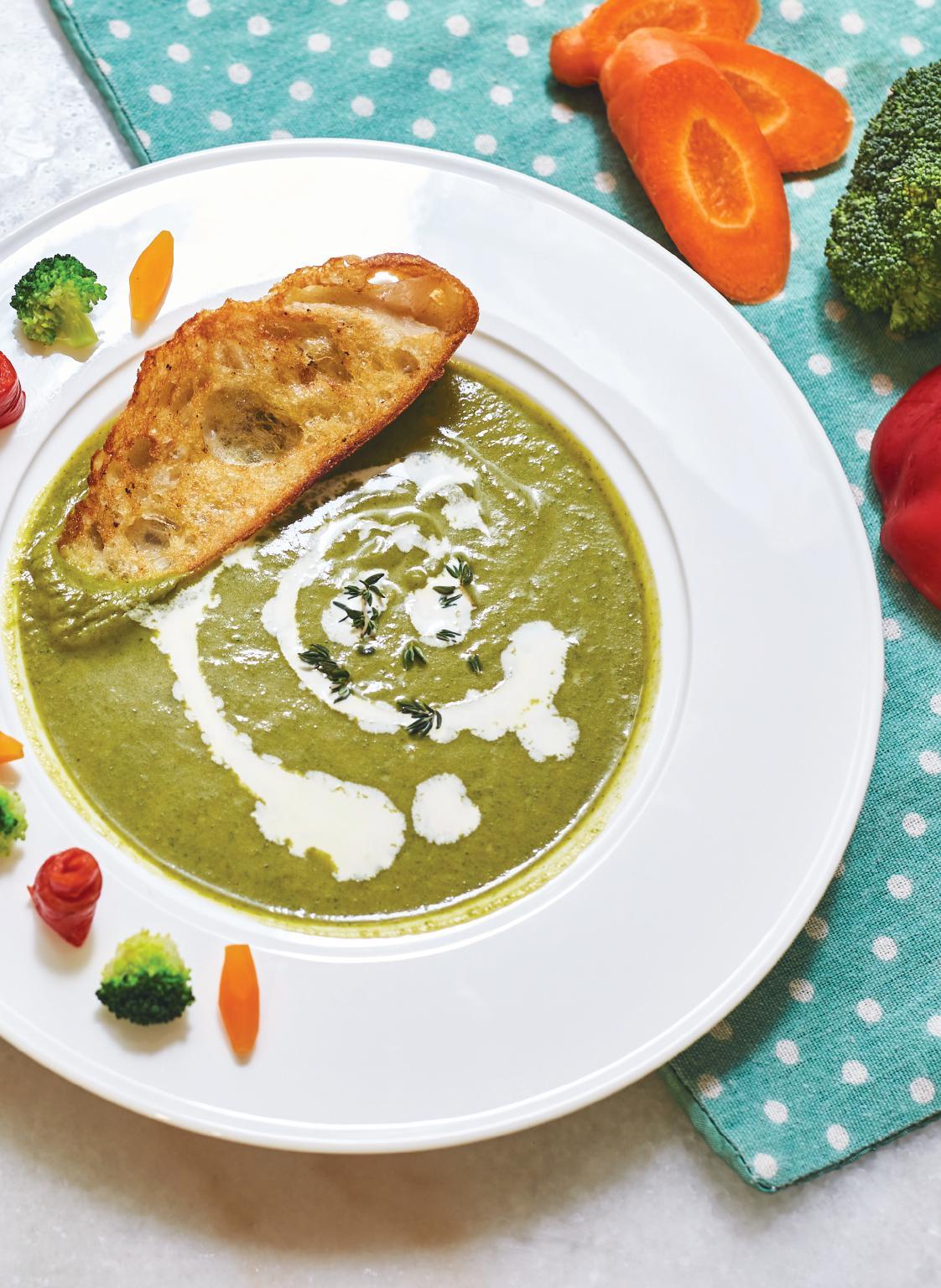
| 33
BABY, IT’S A GOOD TIME TO MOVE!
Pregnancy is a unique time for any woman. During pregnancy, the body undergoes many changes, and exercise may seem daunting. However, barring some exceptions, regular activity while you are expecting brings numerous health benefits.
Apart from reducing sedentary behaviour and its associated
long-term health risks, exercise helps maintain a healthy weight and mental wellness both during and after pregnancy. It alleviates pregnancy-related issues, such as constipation, bloating and backache. More importantly, it can lower the risk of complications that can affect both you and your baby, such as gestational diabetes.
KEEP IT REGULAR AND MODERATE
So, how much exercise should one do while pregnant?
Similar to recommendations for a healthy individual, the American College of Sports Medicine (ACSM) suggests a total of 150 minutes of moderate-intensity exercise or 75 minutes of vigorous-intensity exercise
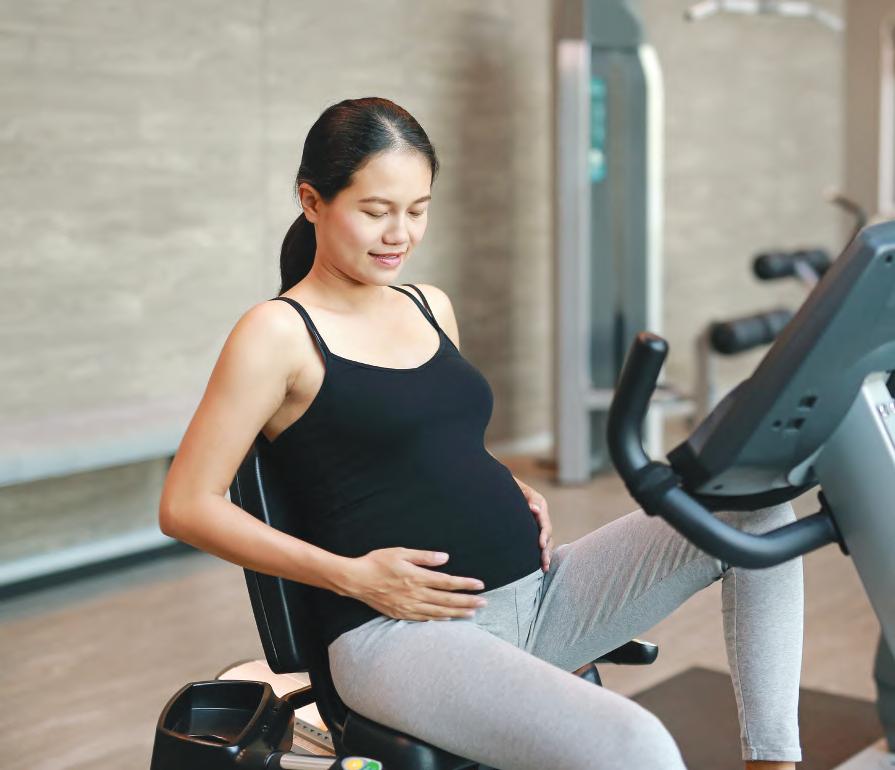
34 | it & Fab
When you are expecting, exercise is one of the best ways to keep discomfort, excessive weight gain, and some complications at bay. In fact, for most healthy women, exercise — before, during and after pregnancy — is an important way to keep mum and baby in the best shape!
By Dr Shauna Sim, Associate Consultant, Sports and Exercise Medicine Centre, KTPH
per week. Ideally, this should be spread across most days of the week.
If you are just beginning a fitness routine, you can start at a slower pace and intensity. Try 5–10 minutes of exercise per session, then gradually increase the duration to about 30 minutes per session.
Choose an exercise you enjoy and can do comfortably. Suitable forms of cardiovascular exercise include lowimpact workouts, such as walking, swimming and stationary cycling. Water sports, such as aqua-aerobics, are particularly suitable towards the end of pregnancy as the buoyancy of water reduces the load on joints.
Apart from getting your heart rate going, you are also recommended to do flexibility exercises, such as stretching, at least two to three times a week. Pelvic floor exercises, such as Kegel exercises, should also be performed daily as these muscles are stretched out and weakened during pregnancy due to hormones and the growing weight of the foetus.
Contrary to popular belief, you should also include resistance exercises. Some examples of this include squats, lunges and even weightlifting. In fact, both the ACSM and Royal College of Obstetricians and Gynaecologists recommend resistance exercise two to three non-consecutive days a week.
If you already do regular resistance training prior to pregnancy, you should be able to continue your routine with clearance from your doctor.
While movements and exercises are encouraged, it is still important to take some precautions and avoid the following:
• Exercises where you need to lie flat on your back after the first trimester
• Exercises that require holding your breath
• Prolonged contracting of a muscle while held in the same position or prolonged motionless standing
• Scuba diving, to avoid the risk of decompression sickness
• Contact sports, such as soccer, basketball and volleyball
• Activities with a risk of falling from height, such as rock climbing
• Activities that involve hitting water with force, such as water skiing, surfing and diving
BODILY CHANGES TO EXPECT
To exercise safely while pregnant, keep in mind that your body undergoes many changes that can affect the way you work out.
For one, you will have a higher metabolic demand, so ensure that you monitor your weight and that
GET YOUR DOCTOR TO GIVE YOU THE OK!
It is important to talk to your doctor if you plan to exercise while pregnant, especially if you:
• Have a history of pre-term labour, ruptured membranes, incompetent cervix, placental issues, or multiple gestations
• Have medical issues during pregnancy, such as high blood pressure
• Have severe pre-existing medical conditions, such as a heart or lung disease
If at any time there is vaginal bleeding, shortness of breath, chest pain, calf pain or swelling, dizziness, decreased foetal movement, or signs of pre-term labour, exercise should be stopped and you should seek medical attention immediately.
you are not losing too much weight, which may be harmful to the foetus. You will also be more prone to heat injury, so it is important to stay well hydrated and appropriately clothed, and avoid exercising in hot and humid environments. In addition, you will experience an increased need for oxygen uptake, as well as decreased tidal volume for the lungs, which could lead to a greater risk of breathlessness. As such, opt for lower-intensity exercises where possible.
As the pregnancy progresses, your centre of gravity will shift as the foetus grows larger. This can affect your balance and put more stress on your lower back and pelvis. To prevent pain and injury during this period, choose exercises that do not put additional stress on these areas. You may also find that your joints are looser and more mobile due to pregnancy hormones, so it is important to move more mindfully when stretching and avoid highimpact activities that could adversely affect the joints.
Keeping in mind these precautions, go on and get active! Regular exercise can help you cope with the many physical changes of pregnancy, and even build up stamina for the future challenges of motherhood.
| 35

















































































